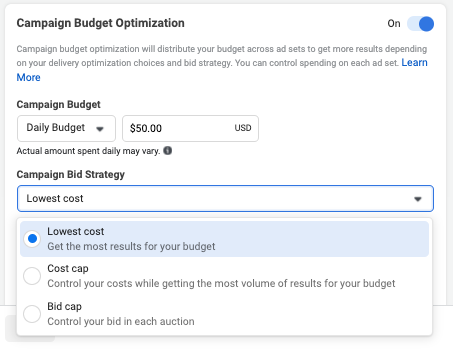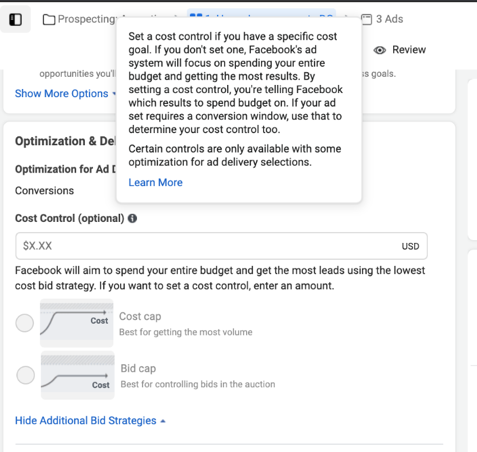February 10th, 2021
The power of Facebook’s ad platform is two-fold: It’s ability to target specific audiences across its apps and the machine learning technology it uses to optimize an advertiser’s ad spend. Because of Facebook’s advanced capabilities, it is able to maximize an advertiser’s budget based on their campaign objective and available funds. But, the key to creating effective campaigns involves understanding Facebook’s ad cost and bid control functions so that you can enable a bid strategy that aligns with your primary goal.
Facebook offers three specific bid strategy options within the ad set level: Cost cap, Bid Cap and Minimum ROAS (return on ad spend). Each comes with separate benefits depending on your campaign objective. As Facebook states in its Bid Strategy Guide, to know which bid strategy will work best for you, “You’ll need to first identify your overall Facebook objective and your primary KPI.”
What are Facebook Ad Cost and Bid Controls?
Before selecting a bidding strategy, it’s crucial Facebook advertisers understand what exactly cost and bid controls are. At the most basic level, Facebook’s ad cost and bid controls allow advertisers to control how much money they spend on a campaign while simultaneously maximizing their ad spend based on campaign objectives.
By selecting a bid option, an advertiser is telling Facebook what algorithm to use when making a bid in the ad auction. In other words, the advertiser is telling Facebook to use their ad spend in a way that delivers a specific goal, i.e. driving conversions while controlling costs.
To make sure a bid strategy aligns with your campaign objective, Facebook offers the following controls:
Cost cap: The Cost Cap bid option allows advertisers to “cap the cost of the results they are optimizing for.” In other words, if you’re a retail marketer wanting to optimize for purchases, you would set your Cost Cap at the maximum cost per purchase that will keep your ad efforts profitable.
Bid Cap: The Bid Cap option is used when an advertiser wants to set the maximum bid across all ad auctions versus letting Facebook bid dynamically based on the advertiser’s goals. This option is most often leveraged by experienced Facebook advertisers who use internal bidding or LTV (lifetime value) models and are able to calculate bids based on projected conversion rates and marginal costs.
Minimum ROAS: The Minimum ROAS (return on ad spend) option makes it possible for an advertiser to target a minimum return on ad spend for each bid. According to Facebook’s example, if the advertisers goal is to drive at least $110 in purchases based on a $100 ad spend, the Minimum ROAS setting would be 1.100.
Best Practices: How to use Facebook Ad Cost and Bid Controls effectively
Each of Facebook’s bid options come with specific benefits based on your campaign objective. For advertisers using Facebook’s Campaign Budget Optimization (CBO) function, you will select your bid strategy — Cost Cap, Bid Cap or Lowest Cost — during the campaign creation and then the control amount within each ad set via the “Optimization for delivery” screen.

The primary difference between the three options? Cost cap controls the cost of your results while getting the greatest volume of results for your budget, while Lowest Cost will get you the most results for your budget without any additional controls at the ad set level. Bid Cap allows advertisers to manually cap how much Facebook bids in auctions.
When to use Cost Cap as your bidding strategy
For advertisers who base their performance on cost, Facebook recommends using the Cost Cap bidding strategy so that they can optimize their campaign around the set cost: “If you’re looking to scale your business by driving as many subscriptions or purchases as possible — and must stay within a specific cost per optimization event — we recommend you use Cost Cap.”
Cost cap is a prime strategy when you need to keep your cost per acquisition (CPA) at or below a certain dollar value. Think of Cost Cap as a way to go after the lowing-hanging fruit as it aims to minimize cost by delivering the cheapest results first. It’s worth noting that the “learning phase” may take longer to exit for Cost Cap campaigns than other bidding strategies — but once your campaign exits learning, ad delivery will stabilize.
“If you’ve hit your cost control, [ad] delivery can slow down as we optimize for more results within your cost control,” according to Facebook, “Increasing your budget might not deliver more conversions, and it’s unlikely you’re able to fully spend your budget without also raising your cost control.” Should this happen, Facebook recommends updating creative or expanding your audience to increase delivery.
When to use Bid Cap as your bidding strategy
While the Cost Cap strategy is focused on controlling costs, the Bid Cap option is focused on driving conversions at your maximum bid amount. According to Facebook, the Bid Cap option does not control for the CPA numbers you see in reporting and will require more frequent bid changes.
“Because it runs on a second-tier auction, it may not reflect the cost you actually pay,” according to Social Media Examiner, “For example, if you bid a cost per click of $5 and win the auction against another advertiser that bid $3.50 per click, you’ll be charged $3.50 for that click even though you set your Bid Cap at $5.”
Because of how this feature works, a low bid can limit or prevent delivery of your ad. You will know if you’ve set the bid amount too low if you receive a “Bid Limited Delivery” notification in Ads Manager.
The Bid Cap option is a competitive ad tool for generating the most ad opportunities within your set budget: “By setting a bid control using the Bid Cap strategy, that tells us the maximum amount we can bid across auctions to reach your target audience.”
When to use Minimum ROAS as your bidding strategy
Facebook’s Minimum ROAS bidding option is aimed at advertisers who have a specific return on ad spend they want to meet. It is designed for marketers who want more control over the purchase value they generate from their ad campaigns versus what is possible using the highest value bid strategy. (The highest value bid strategy is when Facebook is directed to spend your entire ad budget by the end of the ad set’s schedule.)
“When you use Minimum ROAS, we’ll target a minimum return on ad spend for each bid,” writes Facebook. Because the Minimum ROAS bid strategy is connected to value optimization campaigns, it requires an advertiser to have a Pixel installed on their website to pass back purchase values. To set this bidding strategy up, you’ll need to optimize your ad set for purchase value using value optimization. With the forthcoming iOS 14 software update impacting Facebook Ads, you will now need to make some additional configurations in Events Manager.
Same as the Bid Cap option, the Minimum ROAS bidding strategy requires advertisers to calculate bids based on projected conversion rates and marginal cost.
These bid options are all effective and can reap generous rewards when used correctly. For advertisers not using CBO, Facebook will automatically select the Cost Cap bidding strategy when the advertiser enters their cost control amount in the “Optimization for Ad Delivery” section of the ad set creation. If the advertiser wants to switch to a Bid Cap strategy, they will have to select it manually via the “Show Additional Bid Strategies” option.

Minimum ROAS is only available to advertisers who have optimized the delivery of their ad set for value and have met Facebook’s eligibility requirements.
Facebook offers advertisers a world of opportunities, but setting the budget for those opportunities can be challenging. If you need help understanding which ad cost and bid control options will best align with your marketing goals, schedule a call with AKvertise. We can help you maximize your Facebook and Instagram budget and make sure your bid strategies align with your campaign objectives.
Share: